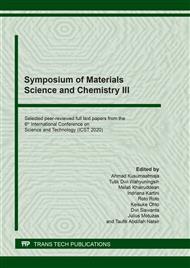[1]
ICO, Coffee production by exporting countries, International Coffee Organization, London, (2019).
Google Scholar
[2]
J.S. da Silveira, N. Durand, S. Lacour, M-P. Belleville, A. Perez, G. Loiseau, M. Dornier, Solid-state fermentation as a sustainable method for coffee pulp treatment and production of an extract rich in chlorogenic acids, Food Bioprod. Process. 115 (2019) 175-184.
DOI: 10.1016/j.fbp.2019.04.001
Google Scholar
[3]
D. Silva, K. Tokuioshi, E.D.S. Martins, R. da Silva, E. Gomes, Production of pectinase by solid-state fermentation with Penicillium viridicatum RFC3, Process Biochem. 40 (8) (2005) 2885-2889.
DOI: 10.1016/j.procbio.2005.01.008
Google Scholar
[4]
K. Muzakhar, A consortium of three enzymes : xylnase, arabinofuranosidase and cellulase from Aspergillus sp. which liquefied pulp waste, IOP Conf. Ser.: Mater. Sci. Eng. 546 (2) (2019) 022013.
DOI: 10.1088/1757-899x/546/2/022013
Google Scholar
[5]
E.S. Martins, D. Silva, R. da Silva, E. Gomes, Solid state production of thermostable pectinases from thermophilic Thermoascus aurantiacus, Process Biochem. 37 (9) (2002) 949-954.
DOI: 10.1016/s0032-9592(01)00300-4
Google Scholar
[6]
B. Rivas, A. Torrado, P. Torre, A. Converti, J.M. Domínguez, Submerged citric acid frmentation on orange peel autohydrolysate, J. Agric. Food Chem. 56 (7) (2008) 2380-2387.
DOI: 10.1021/jf073388r
Google Scholar
[7]
U. Hasanah, M. Setyowati, Edwarsyah, R. Efendi, E. Safitri, R. Idroes, L.Y. Heng, N.D. Sani, Isolation of Pectin from coffee pulp Arabica Gayo for the development of matrices membrane, IOP Conf: Ser.: Mater. Sci. Eng. 523 (2019) 012014.
DOI: 10.1088/1757-899x/523/1/012014
Google Scholar
[8]
K. Roy, S. Dey, Md.K. Uddin, R. Barua, Md.T. Hossain, Extracellular pectinase from a novel bacterium Chryseobacterium indologenes strain SD and its application in fruit juice clarification, Enzyme Res. 2018 (2018) 3859752.
DOI: 10.1155/2018/3859752
Google Scholar
[9]
D.R. Kashyap, P.K. Vohra, S. Chopra, R. Tewari, Applications of pectinases in the commercial sector: a review, Bioresour. Technol. 77 (3) (2001) 215-227.
DOI: 10.1016/s0960-8524(00)00118-8
Google Scholar
[10]
G. Aguilar, C. Huitrón, Conidial and mycelial-bound exo-pectinase of Aspergillus sp., FEMS Microbiol. Lett. 108 (2) (1993) 127-132.
DOI: 10.1111/j.1574-6968.1993.tb06087.x
Google Scholar
[11]
K. Muzakhar, Sutoyo, A.B. Saragih, Phosphate Solubilizing Bacteria Adaptive to Vinnasse, J. Math. Fundam. Sci. 47 (2) (2015) 219-225.
DOI: 10.5614/j.math.fund.sci.2015.47.2.8
Google Scholar
[12]
L. Ikasari, D.A. Mitchell, Protease production by Rhizopus oliigosporus in solid-state fermentation, World J. Microbiol. Biotechnol.10 (1994) 320-324.
DOI: 10.1007/bf00414872
Google Scholar
[13]
K. Muzakhar, R. Winarsa, Activity of α-L-Rhamnosidase proced by Aspergilluus niger during solid state fermentation of coffee pulp wastes, J. Biodjati. 4 (1) (2019) 105-111.
DOI: 10.15575/biodjati.v4i1.4411
Google Scholar
[14]
S. Ubaidillah, K. Muzakhar, Sugar-rich hydrolyzates from coffee pulp waste which produced under solid state fermentation by Pestalotiosis sp. VM9 and Aspergillus sp. VTM 5, and its effenciency as medium for single cell protein Saccharomyces cerevisiae, IOP Conf. Ser.: Mater. Sci. Eng. 546 (6) (2019) 062033.
DOI: 10.1088/1757-899x/546/6/062033
Google Scholar
[15]
K. Muzakhar, Masruroh, Siswoyo, R. Winarsa, Sutoyo, Sugar-rich hydrolysates of palm oil empty fruit bunch production through two step solid state fermentations and its conversion to ethanol, Adv. Sci. Lett. 23 (3) (2017) 2533-2535.
DOI: 10.1166/asl.2017.8684
Google Scholar
[16]
Z.W. Strain, G. Coral, Some Properties of crude carboxymethyl cellulase of Aspergillus niger Z10 wild-type strain, Turk. J. Biol. 26 (4) (2002) 209-213.
Google Scholar
[17]
V.H. Vu, T.A. Pham, K. Kim, improvement of fungal cellulase production by mutation and optimization of soolid state fermentation, Mycobiology. 39 (1) (2011) 20-25.
DOI: 10.4489/myco.2011.39.1.020
Google Scholar
[18]
K. Mojsov, Experimental investigations of submerged fermentation and synthesis of pectinolytic enzymes by Aspergillus Niger: effect of inoculum size and age of spores, Appl. Technol. Innov. 2 (2) (2010) 40-46.
DOI: 10.15208/ati.2010.13
Google Scholar
[19]
S.C. Sati, S. Bisht, Utilization of various carbon sources for the growth of waterborne conidial fungi, Mycologia. 98 (5) (2006) 678-681.
DOI: 10.3852/mycologia.98.5.678
Google Scholar
[20]
T. Sander, N. Farke, C. Diehl, M. Kuntz, T. Glatter, H. Link, Allosteric feedback inhibiton enables robust amino acid biosynthesis in E.coli by enforcing enzyme overabundance, Cell Syst. 8 (1) (2019). 66-7.
DOI: 10.1016/j.cels.2018.12.005
Google Scholar
[21]
D.B. Pedrolli, A.C. Monteiro, E. Gomes, E.C. Carmona, Pectin and pectinase: production, characterization and industrial application of microbial pectinolytic enzymes, Open Biotechnol. J. 3 (1) (2009) 9-18.
DOI: 10.2174/1874070700903010009
Google Scholar


